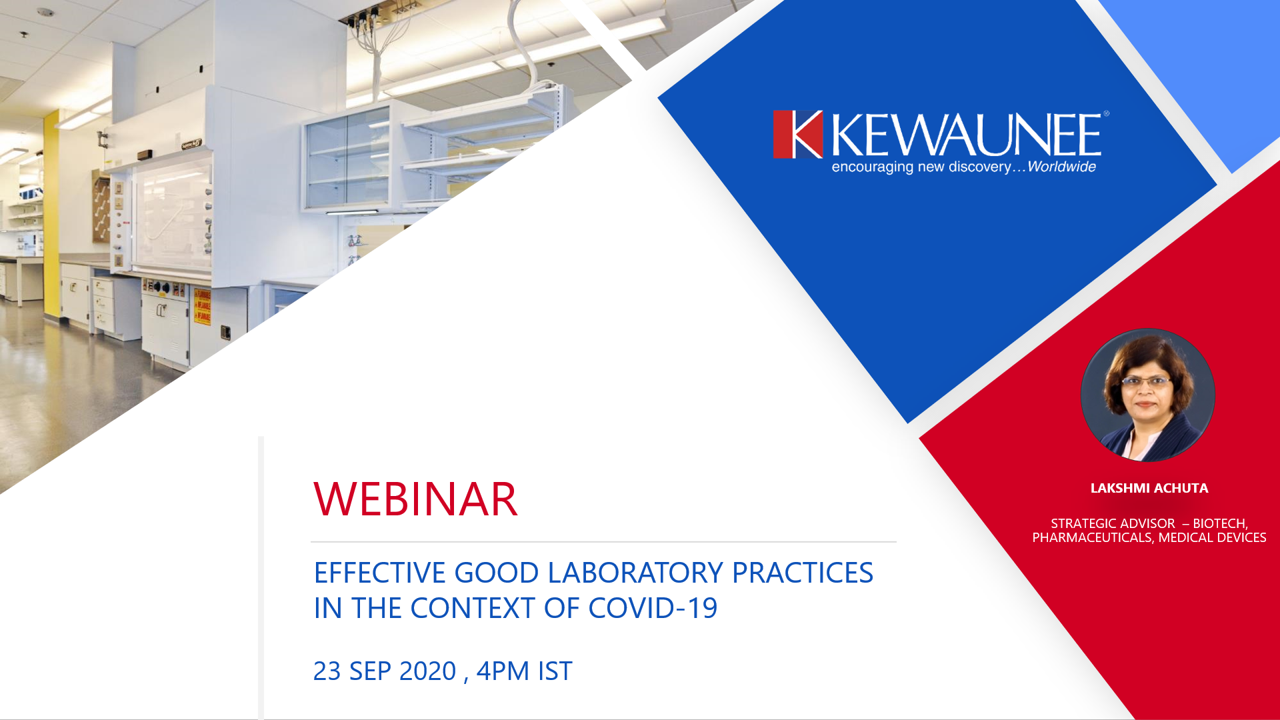Effective Good Laboratory Practices Covid19
GLP or Good Laboratory Practice is an international standard to guarantee the quality, consistency and reliability of data generated and accumulated through laboratory studies.
GLP embodies a set of principles (OECD, FDA, EPA, ISO) providing a framework within which laboratory studies are planned, performed, monitored, recorded, reported and archived. Principles of GLP intend to promote the quality and validity of test data generated in laboratories.
This webinar will show the importance of addressing the GLP requirements – especially addressing requirements related to COVID-19 management.
WEBINAR RECORDING
PRESENTATION

Effective Good Laboratory Practices in the context of Covid-19
Send download link to:
BECOME A THOUGHT-LEADER
Would you like to be the next speaker on the webinar? Drop us a note and we’ll get in touch with you.
Q&A SESSION
Organizations have procedures for archival and retrieval of both paper and electronic documents; however, no specific guideline. Refer to OECD Series on Principles of Good Laboratory Practice and Compliance Monitoring; Number 15: Establishment and Control of Archives that Operate in Compliance with the Principles of GLP and 21 CFR part 58 where relevant information related to retrieval have been indicated.
BSL4 are highly regulated labs, since they handle agents that might be aerosol transmitted and can cause severe to fatal disease in humans for which there are no available vaccines and treatments.
Organizations have procedures in place for:
- Self declaration (they can show if they are primary /secondary contact)
- Check temperature / oximeter twice a day
- Restrict employees within the GLP area (employees come in shift / alternate day and so on) so that there are less numb of people
- If they are +ve, then contact tracing is enabled by the organization
- Home quarantine / institution quarantine, as relevant
Though OECD and 21 CFR part 58 have similarities, requirements of Part 58 should be followed (besides that of OECD GLP) if studies are being submitted to USFDA.
Because of the pandemic, there could be instances of deviations from the study protocol, change in study director and so on. Document all deviations in COVID-19 viz., delay in calibration, study related procedures, etc.
GLP is for pre-clinical (or non-clinical) studies related to animals and clinical studies are related to humans. For clinical labs (in India), ISO 15189 (as per NABL) requirements have to be addressed. Bioanalytical labs which analyze samples of animal origin have to address OECD requirements.
No drugs are tested on pregnant women because of ethical considerations.
It is mandatory if pre-clinical studies (or non-clinical) are being conducted in the lab.
Please refer to the document – OECD GLP principles of GLP for more information; also, industry and national standards are taken into considerations while designing the infrastructure. Refer here.
Though this requires a separate discussion based on the Medical Devices that you are referring, following can be considered:
Recommendations for GLP/non-GLP conduct of device regulatory studies.
| Study Type | GLP, non GLP, or GMP |
| Biocompatibility (both in-vivo and in-vitro) | GLP |
| Validation Studies (sterilization validations, reusable device cleaning validations) | GLP (most likely) not needed |
| Exploratory Studies | GLP not needed (non GLP) |
| Chemical Characterization Studies (such as ISO 10993-18 Chemical Characterization) | GLP (most likely) not needed |
| Routine Lot Testing (bioburden, endotoxin, sterility) | Conduct according to GMP (Good Manufacturing Practices) |
Depending on the analysis, organizations conduct it annually or once in six months (or even quarterly). They also participate in Proficiency testing in accredited labs (and the frequency varies).
Decontamination procedures vary depending on the material to be disposed. The material should be deactivated (chemical / microbe / biological sample) prior to disposal.
GLP is a standard for conducting non-clinical studies; whereas ISO 17025 is an international standard for calibration and testing laboratories across industries (viz. mechanical, chemical, etc) and is governed by National Accredited Board of Testing & Calibration Laboratories (NABL, India). There are similarities and differences – refer here.
Laboratories involved in the drug development process wherein the data generated is submitted for regulatory submissions should have qualified equipment and instrument.
Effective containment procedures and practices should be in place, which enables the control of seepage – viz. containers used should be integral (leak proof) and so on; personnel handling it should be well trained.
USFDA – 21 CFR Part 11 Electronic Records; Electronic Signatures – Scope and Application; EU – Annex 11: Computerised Systems.
Air quality is essential in lab space as a norm – there should be more cleaning and sanitation, during the COVID-19, of air filters.
There are guidelines for the building and facilities in regulations, the same is used as guidelines during the selection process (based on the activity being done). There are industry benchmarks and practices that are considered.
21 CFR part 58 is a USFDA regulation; OECD GLP is an international standard which is adopted and monitored by the regulators across the world. For detailed differences refer here.
Virus doesn’t survive in air for a long time and at higher temperatures. So, the exhaust air can be heated up to ensure that viruses are inactivated.
Yes, HVAC is required. The minimum lab set up has to meet BSL 2 criteria. Air can be recirculated with at least 30% exhaust and exhaust from BSL cabinet.
Software must meet the requirements of USFDA – 21 CFR Part 11 Electronic Records; Electronic Signatures – Scope and Application; EU – Annex 11: Computerised Systems.
This is based on the laboratory operations and the overall management directive. Samples are received at the laboratory (GLP lab personnel are not involved in sampling).
Refer here.
Animal studies from which data generated is submitted for regulatory submissions should be conducted under GLP.
Per the Government and Organization norms.
Depends on the research being done. If it is required for any regulatory submission / patent / client requirement, then those requirements for archival / storage have to be considered.
Training lab may not require GLP certification. But, if the lab intends to handle non-clinical samples, this has to be re-looked into – taking into ethical considerations.
Studies can be done in GLP certified CRO (Contract Research Laboratories), the list is published by the National GLP Compliance Authorities of the country. Refer here.
Depends on the requirement and based on the decision of the National GLP Compliance Authorities of the country.
Training lab may not require GLP certification. But, if the lab intends to handle non-clinical samples, this has to be re-looked into – taking into ethical considerations.
In case the calibration has not been done, a deviation has to be taken as per Quality management Systems, risk assessment (including review of previous calibration records, etc) to be done and then calibration to be undertaken. Instruments not in calibration may produce faulty results.
GLP certification is for laboratories conducting non-clincial studies.
Disclaimer: This is a guest post. The views and opinions expressed in these articles are those of the author and do not necessarily reflect the official position of Kewaunee, who shall not be held liable for any inaccuracies presented.
Comments are closed.











